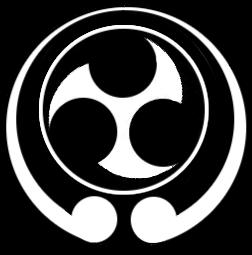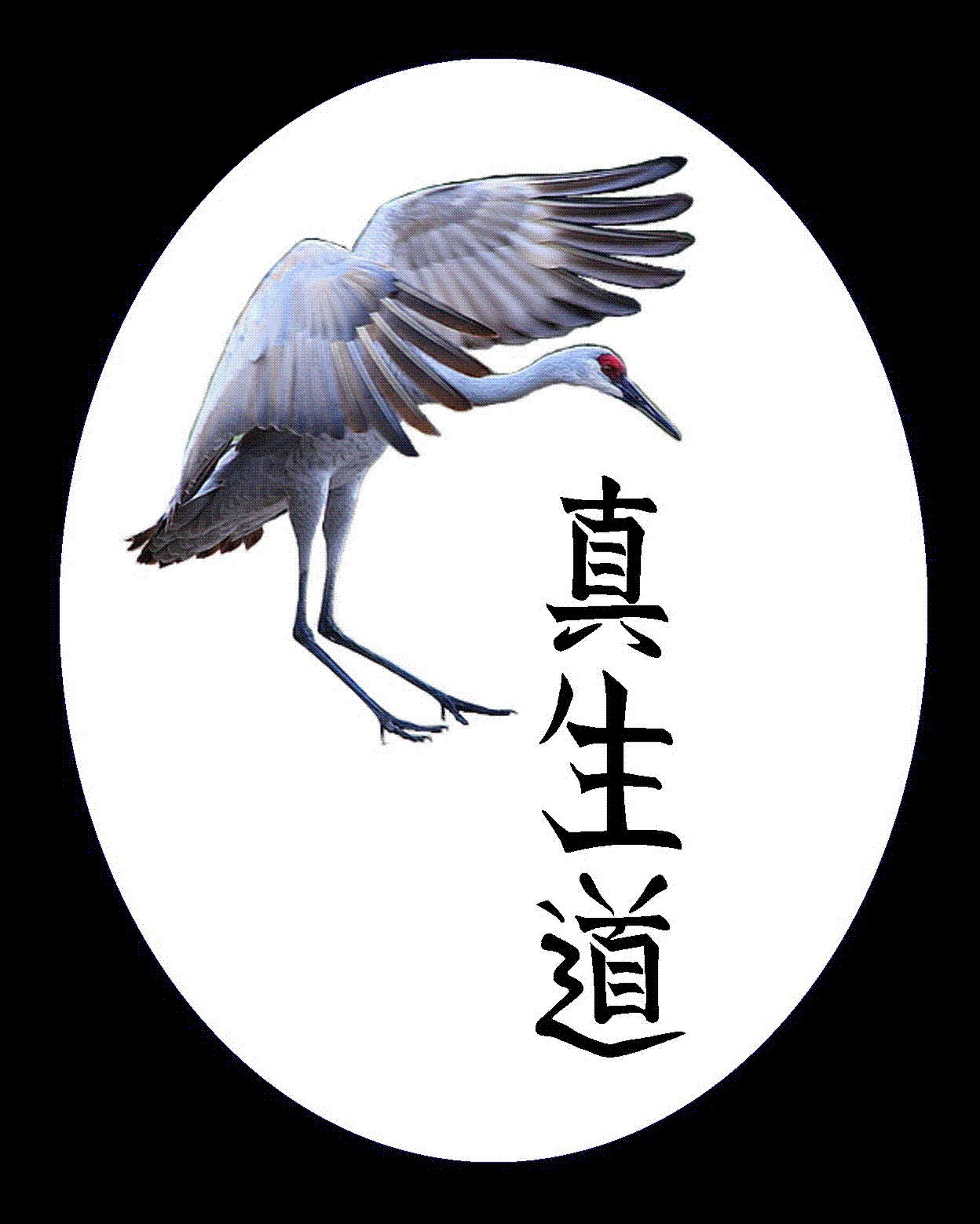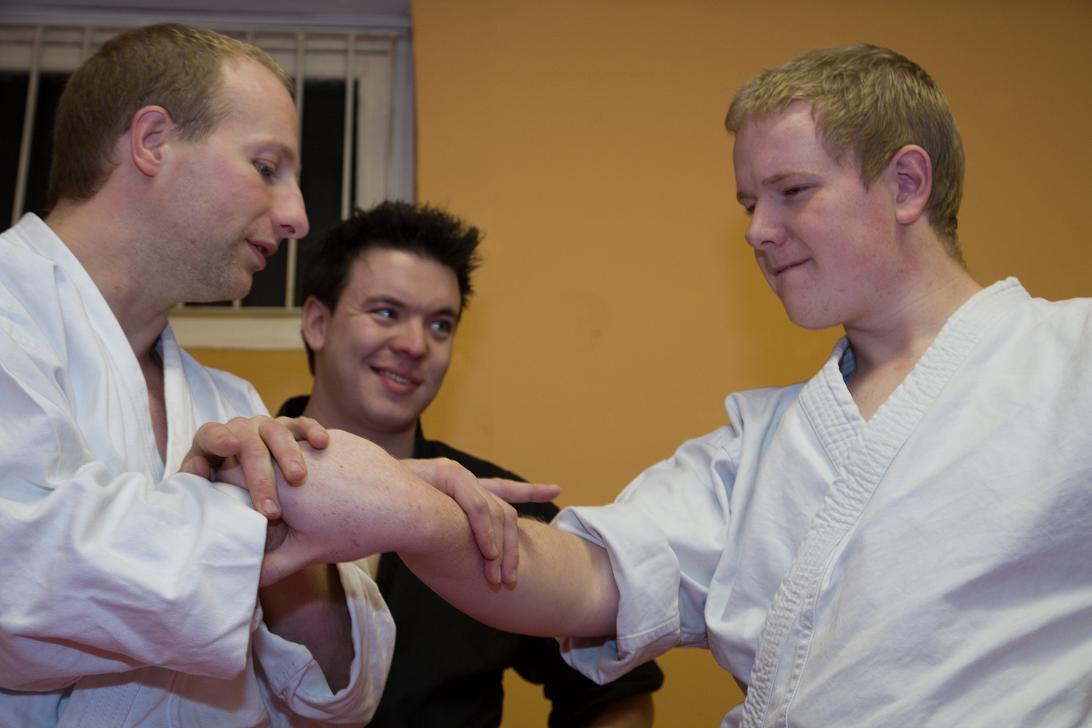
![]()
![]()

Headingley Karate
|
|
|
Colour Visualisation and Vibration Techniques
by Zoltan Dienes
In April 1998 I attended a seminar by Rick Moneymaker, of the DSI (Dragon Society International). He taught various principles or "players to the game" that he argued would improve ability to apply techniques. Having been shown the players, many people at the seminar tried the players and agreed, perhaps to their suprise, that the players were effective. I would like to argue that various of these principles taught by DSI for improving the effectiveness of a technique may not in reality do so, despite the genuinely favourable experiences of people taught the principles in a seminar setting.
I have looked at the following principles in more detail, as they apply to the centre lock (nikyo):
1. Imagining a colour flowing from yourself into the uke;
2. Vibrating your arm.
At the seminar, Rick Moneymaker suggested that if we tried either of these principles we would find that to get the same effect on our uke we would only need to apply half the effort. Indeed, many people were surprised at just how true this was.
The explanations given to us were in terms of traditional Chinese medicine. When flowing a colour we were asked to use yellow. Each element is associated with a colour, and yellow happened to be right for the move we were using. Maybe for vibration we were producing the resonant frequency of the organ whose meridian we were attacking. But the exact explanation doesn't matter for my purposes; just that there was an explanation offered that people believed and the move worked.
There is a simple explanation of people's experiences that needs to be ruled out before more exotic explanations can even be considered. Experimental psychologists have repeatedly demonstrated the power of belief and expectation in moulding people's experiences. The simple explanation is this: People experienced the move as being easier simply because that was what was suggested to them.

Nikyo - the wrist-lock used in this experiment
|
I divided the class into two groups of nine. Another instructor took one group through some kicks, I worked on 'principles for making an effective S-shaped lock' with my group. After some practice getting the mechanics of the move right, I gave them instruction set A below (verbally), which suggested to them that vibration would make application of the centre lock more difficult. I let them play around with vibration and non-vibration. I asked each person to give me a number reflecting how much more effort did they need to put into the technique with vibration compared to the technique without vibration in order to get the same effect on the uke - if twice as much effort they should say '2', if the same '1', and if half as much then '1/2', etc. The I gave them instruction set B below, suggesting to them that flowing blue will increase the effectiveness of the move, but flowing red would decrease the effectiveness of the move. After they played with red and blue, I got ratings on how much more effort did they needed to put in with red in order to get the same effect on the uke as blue.
Then I swapped groups with the other instructor, and repeated the procedure, but this time using instruction sets C and D, suggesting that vibration would increase the effectiveness of the technique, and that red rather than blue would increase the effectiveness of the technique.
Note that any resemblance between explanations in the instructions and reality is purely coincidental - my purpose was to give a convincing story, not a true one!
Here are the mean ratings, where the higher the number means more in accordance with suggested expectations. I have put in brackets the 'standard deviations' of the numbers - this is a measure of the spread of the numbers about the mean. Then I have used a Wilcoxon test to test if the numbers are different from 1 (1 meaning no effect of applying the principle). The value labelled 'p' is the statistical 'significance' of the result - all you need to know is, if this number is less than .05, you can conclude that were effected by the manipulation.
Suggestion:
Vibration decreases effectiveness
Vibration increases effectiveness
Blue increases effectiveness
Blue decreases effectiveness
Notice that in all cases people's average reported experiences were in the direction of the suggestion. Those people told that vibration decreased the effectiveness of the move found they had to apply twice the effort with vibration as without vibration in order to get the same pain on the uke. Those told that vibration increased the effectiveness of the move, needed to apply 50 percent more effort without vibration in order to get the same effect as with vibration. In both cases I heard people say 'wow, it really makes a difference'! For colours it can be seen the results show exactly the same pattern, if somewhat weaker in magnitude. People were amazed at how 'effective' the principle was that I had taught them.
Maybe the effects would have been bigger if I had suggested bigger effects (I explicitly suggested a factor of 2 difference). Maybe they would have been bigger if I truly believed what I was saying - no doubt my lack of belief subtly influenced my delivery. Even so the reported effects are LARGE - on average, the different manipulations increased the effectiveness of the move by 30 to 100 percent - that's a BIG improvement in the effectiveness of your technique! That's of the same order as was suggested to us in the seminar I went to. Only trouble is, your technique isn't really any better!
The results cannot be explained by traditional Chinese medicine (TCM). For all I know, TCM predicts neither colour, red or blue, makes a difference - but then why did they make a big difference? Or TCM predicts that one colour should be better than the other - but then the effect should not reverse just because people are told it should reverse. Also, if , in addition to suggestion, there is a real TCM effect in either vibration or colour, it is completely obliterated by the much stronger effect of suggestion.
It should be pointed out that my conclusion as to the ineffectiveness of vibration applies only to the particular type of vibration used when nikyo is practiced. Rubbing actions can be very effective in stimulating some points, such as the golgi bodies above the elbow.
It could be argued that I had not had enough practice in the players - for example, practice in imagining a colour. This is of course true. However, I could get effects of the same magnitude as was suggested to us in the seminar. I did not need any more practice to reproduce what I had observed. Even if this were not so, my substantial point is not undermined - that doing almost anything can double the effectiveness of a move OR halve the effectiveness of the move depending on what people believe. It is incumbent on us as instructors to make sure we do not teach purely arbitrary principles that seem to work only because we believe that they work.
In science, other things being equal, the simplest hypothesis is the one accepted. Thus, while suggestion remains a possible explanation of an effect, other things being equal, it also the best explanation. It is gratuitous in this case to use more exotic principles to explain people's experiences.
I think the moral is that techniques work best when there is conviction and intent. Believing you are performing a weak move will lead you to undermine your own performance - albeit unconsciously. Using imagination can help you think positively about your technique and apply it with commitment - but you can imagine whatever works for you, there is no need to pay large sums of money to be told what to imagine in different situations.
Instructions for techniques
A. Vibration makes the technique less effective
"When you perform tuite - or grappling - it is important to move smoothly with intent. It is often good to change direction suddenly to off-balance the opponent, but this isn't done in a jerky way because that makes the opponent tense. It is best to 'fool' the opponent into relaxing so there is minimal resistance to your technique. I belong to an internet kyusho discussion group, and one instructor wondered if it might be good to shake or vibrate as you perform locks. It turned out with careful experimentation that this is just the opposite of what you should do: Because back and forth motions actually relieve pain. Just like when you rub a sore part of you to relieve it. Or when you bounce when stretching - bouncing is no good for stretching but it FEELS good because it relieves pain. The vibration acts directly via a spinal reflex 'gating' the pain. I want you to experience this for yourself. Perform the centre lock smoothly, and also by vibrating like this [demonstrates], just like you were shaking from the cold, or its been a day or two since your last pint. Perform the centre lock both ways, and use just enough effort to get the same effect on your uke. Notice how much less effort it takes to make the smooth motion work rather than the shaking motion - something like half as much effort, or even less. Minor differences in technique can make a BIG difference in effect so be very careful."
B. Flowing blue but not red makes the technique more effective
"It has long been known that different colours have effects on people. For example, if you want to calm someone down, put them in a blue room rather than a red room. Red is associated with blood and flushed faces and excitement. Blue with the sky and the ocean, which is very calming. The ancients knew of the connection between colours and psychological responses, and argued that imagining different colours increased the effectiveness of different types of attack. Pressure points were said to lie on different meridians, associated with different elements and colours. For this move, the centre lock, for the way we are doing it, you are using a water meridian to attack a fire meridian. Imagining blue flowing through your arm, into the opponent, and out his opposite leg increases the amount of water used in the attack and dramatically increases the move's effectiveness. On the other hand, imagining red activates your fire meridians, augmenting your opponent's fire, dramatically decreasing the move's effectiveness. You might find this hard to believe, maybe you would prefer to think of it this way: Thinking blue makes you calm, more focussed. Thinking red has the opposite effect. Thinking different colours means you do the move in subtly, almost imperceptibly different ways. But you will be surprised just what a difference the colours make. Try the move with both colours, use just enough effort to get the same effect on your uke. Notice how much less effort it takes to make the move work with blue rather than red - something like half as much effort, or even less. Minor differences in technique can make a BIG difference in effect so be very careful."
C. Vibration makes the technique more effective
"When you perform tuite - or grappling - it is important to move with intent. For some locks, if in addition you vibrate as you perform your technique, it magnifies the effect of the technique many times over. This relies on the principle of 'complex torque'. The rapid motion in different directions fools the brain and it cannot resist the move. The motion also potentiates stimulation to the pain receptors so that they are triggered more easily. I want you to experience this for yourself. Perform the motion smoothly, and also by vibrating like this [demonstrates], just like you were shaking from the cold, or its been a day or two since your last pint. Perform the centre lock both ways, and use just enough effort to get the same effect on your uke. Notice how much less effort it takes to make the vibration motion work rather than the smooth motion - something like half as much effort, or even less. Minor differences in technique can make a BIG difference in effect so be very careful."
D. Flowing red but not blue makes the technique more effective
"It has long been known that different colours have effects on people. For example, if you want to calm someone down, put them in a blue room rather than a red room. Red is associated with blood and flushed faces and excitement. Blue with the sky and the ocean, which is very calming. The ancients knew of the connection between colours and psychological responses, and argued that imagining different colours increased the effectiveness of different types of attack. Pressure points were said to lie on different meridians, associated with different elements and colours. For this move, the centre lock, for the way we are doing it, you are using a fire meridian to attack a metal meridian. Imagining red flowing through your arm, into the opponent, and out his opposite leg increases the amount of fire used in the attack and dramatically increases the move's effectiveness. On the other hand, imagining blue activates your water meridians, extinguishing the fire, dramatically decreasing the move's effectiveness. You might find this hard to believe, maybe you would prefer to think of it this way: Thinking red makes you more alert, fires your adrenalin. Thinking blue calms you down, almost sedates you. Thinking different colours means you do the move in subtly, almost imperceptibly different ways. But you will be surprised just what a difference the colours make. Try the move with both colours, use just enough effort to get the same effect on your uke. Notice how much less effort it takes to make the move work with red rather than blue - something like half as much effort, or even less. Minor differences in technique can make a BIG difference in effect so be very careful."